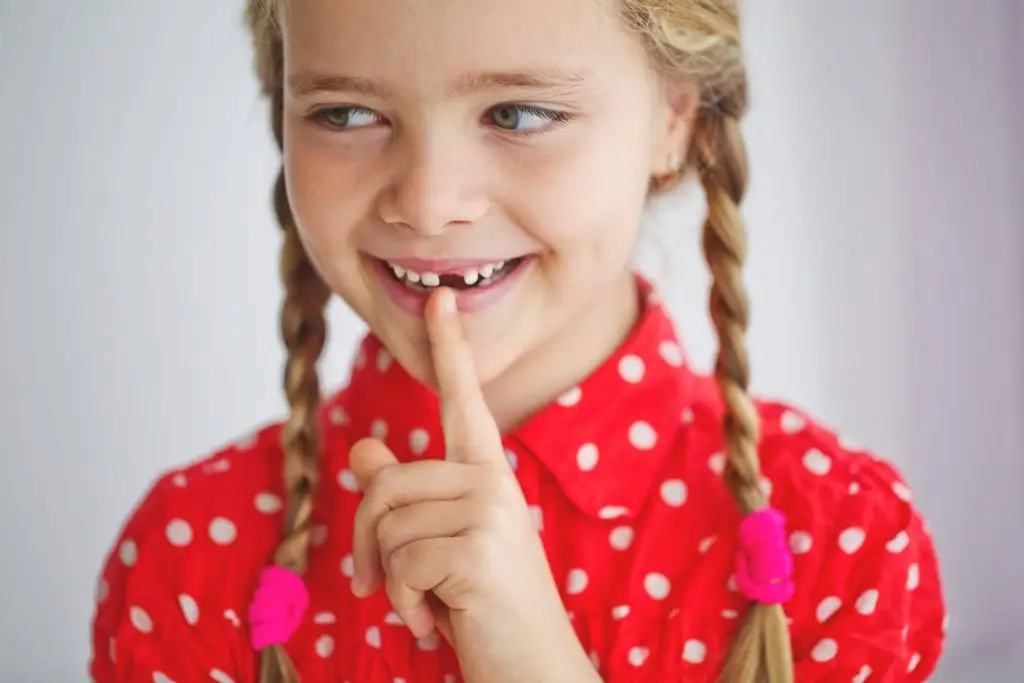A child losing baby teeth and gaining permanent ones usually doesn’t hurt, unlike when those first teeth grow. Most youngsters love this time after they get used to the idea of a tooth being wiggly and discover it doesn’t hurt when it falls out. After all, the Tooth Fairy is involved. It can be a different tale for the parents visiting our Little Kids Dentistry office. They frequently worry about the direction of eruption, whether their child’s loose tooth will fall out, or whether the new permanent teeth will look good. The staff at Little Kids Dentistry is breaking down all the information you need to know about your kid losing baby teeth to soothe your concerns.
¿CUANDO COMIENZA?
The typical age at which a youngster loses their first tooth varies. It is reasonable for parents to worry when their young child doesn’t receive a visit from the Tooth Fairy, but their friends do. Almost all baby teeth charts state that children begin losing their baby teeth between the ages of six and seven. Although this is generally the case, some kids lose their baby teeth as early as age four, while others don’t start until they are seven or even eight. While it may not necessarily indicate a problem, it is best to consult your child’s pediatric dentist if their baby teeth appear to last longer than usual. Because the permanent tooth underneath it forces the baby tooth out as it begins to erupt, a baby tooth nearly always falls out. Though occasionally, harm, cavities, or other problems can cause a baby tooth to fall out without a permanent tooth to replace it. When this occurs, the other teeth often try to fill in the space, which can result in crowding. In these situations, we often use a space maintainer to keep space open for the adult tooth to erupt later.
¿PUEDEN LOS DIENTES DE LECHE SALIR SOLOS? ¿PUEDO AYUDARLOS?
Los dientes de leche suelen caerse solos. Si está flojo y no sale, pídale al niño que lo mueva suavemente con la lengua. Pueden pasar varios meses desde que un diente empieza a moverse hasta que finalmente toca la calle, ya que cada diente pasa por un proceso complejo en el que la raíz se descompone y se absorbe. Por lo tanto, como podría no estar listo, no recomendamos sacarlo ni usar el viejo truco del hilo dental en el pomo de la puerta. La extracción prematura de un diente puede ser perjudicial.
¿EN QUÉ ORDEN PIERDEN LOS DIENTES DE LECHE LOS NIÑOS?
Es una de las preguntas más frecuentes. Los dientes suelen caerse en el mismo orden en que salen. La Asociación Dental Americana ofrece un excelente calendario de erupción de los dientes de leche y permanentes. Por lo general, los dientes frontales inferiores son los primeros en caerse, seguidos de los superiores. Al igual que el orden de los dientes de leche, el resto tiende a caerse simétricamente, lo que significa que el diente de un lado se caerá aproximadamente al mismo tiempo que su compañero del otro lado de la boca. En la mayoría de los casos, los dientes inferiores erupcionan antes que los dientes correspondientes de la arcada superior.
¿CUÁNDO EMPIEZAN A CRECER LOS DIENTES PERMANENTES?
Around the age of six or seven, the first baby tooth—most likely one of the lower front teeth—should come out, and the next tooth should be a permanent one. If a baby tooth comes out and is not replaced by a permanent tooth within six months, speak to your child’s pediatric dentist. The tooth may just be taking its own time coming in, or it may result from a congenitally absent tooth. We’ll investigate and make sure your child’s smile development continues.
The first permanent molars also erupt between the ages of six and seven, which is why they are frequently referred to as the “six-year molars,” along with the replacement teeth.
Kids have “mixed dentition,” or a combination of primary and permanent teeth, from the moment they begin losing baby teeth until the last one is lost. The mixed dentition stage lasts until a child is 12 or 13 years old. Kids have all their adult teeth until the wisdom teeth at this age, after the permanent second molars erupt. If the wisdom teeth come in at all, it typically happens between the ages of 17 and 21.
Dado que los dientes permanentes deben durar toda la vida y no hay repuestos disponibles si se caen, el cuidado bucal es más crucial que nunca. Anime a su hijo a usar hilo dental una vez al día, a limitar la ingesta de alimentos y a cepillarse los dientes permanentes dos veces al día. Además, manténgase al día con sus revisiones y limpiezas dentales de rutina.
Remember that every child is different, and those first teeth often fall out when they’re ready. Visit Little Kids Dentistry if you have questions or worries about how your child’s smile is developing. We’ll collaborate with you to maintain the strength and health of your child’s teeth.

